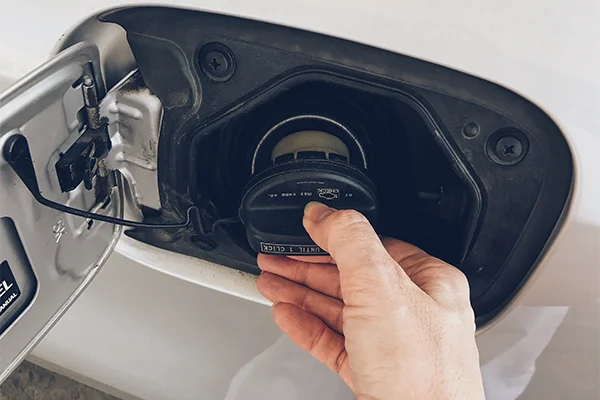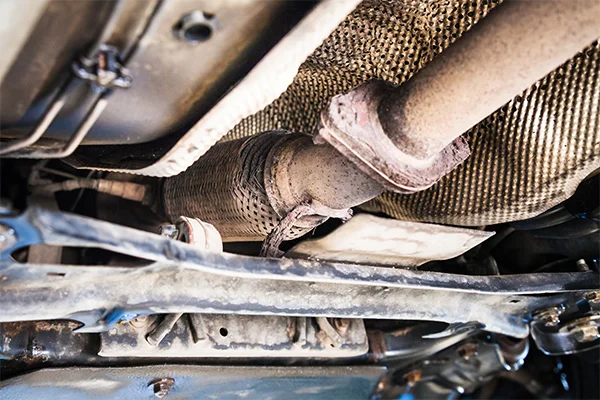Common Causes of Check Engine Light
Noticing an active check engine light (or “service engine” light) on your dashboard can be unsettling, especially if you’re not sure what triggered it. That little orange or yellow light is your car’s way of saying, “something’s wrong,” but it doesn’t always mean something catastrophic. Causes of check engine lights can range from minor issues to potential engine failure, and should always be taken seriously.
If you see your light illuminate, it’s important to have the fault code read and possibly further inspection of the affected area as soon as possible. While reading the specific code can provide a great ballpark estimate of the vehicle’s problematic system in question, the true source of many issues can only be confirmed with diagnostics.
With that said, here are five of the most common causes of check engine lights that you should be aware of.
Loose or Damaged Gas Cap
One of the simplest, and most frequent, reasons for the check engine light to come on is a loose or damaged gas cap. If your gas cap is not tightened properly, or the seal around it has broken, it may cause a drop in pressure in the fuel system, triggering the light. This issue is often overlooked, but it’s a quick fix—just tighten the cap, or if it’s cracked or damaged, have it swapped out. Replacement fuel caps are generally very cheap, and an easy way to both protect your car and keep that pesky light off. If the check engine light doesn’t turn off after this, you may need to have the vehicle checked by your trusted mechanic.

Faulty Oxygen Sensor
Your vehicle’s oxygen sensors (or O2 sensors) measures the level of unburned oxygen present in the exhaust system. This helps the engine’s computer adjust the fuel-to-air ratio, which ensures that your engine runs at optimal efficiency. A malfunctioning or damaged oxygen sensor can lead to poor fuel economy and increased emissions. If allowed to linger, it can gradually also cause more extensive engine damage over time. If your check engine light is on and you notice a drop in fuel efficiency or rough engine performance, it might be time to have the O2 sensor replaced.
Worn-Out Spark Plugs
Spark plugs are essential for igniting the air-fuel mixture in your engine’s cylinders. Over time, these crucial components will gradually wear and will eventually fail. A faulty or failed plug can cause the engine to misfire, idle roughly, or even struggle to start. This can trigger the check engine light, and continuing to drive with worn-out spark plugs can lead to reduced performance, lower fuel efficiency, and increased emissions. If you notice rough idling or hesitation while accelerating, your spark plugs may be the culprit.
Dirty or Failed Mass Airflow Sensor
The mass air flow (MAF) sensor measures the amount of air entering the engine, allowing the engine control unit to inject the proper amount of fuel for efficient combustion. If the MAF sensor fails or becomes contaminated by dirt and debris, it can cause issues with fuel economy, engine performance, or even lead to the stalling. A failed or dirty MAF sensor will often trigger the check engine light and may result in poor acceleration and reduced fuel efficiency. If this sounds familiar, a professional inspection and replacement of the sensor may be necessary.
Catalytic Converter Problems
The catalytic converter reduces harmful emissions from your engine and plays a critical role in the exhaust system. If it becomes clogged or damaged, your car may experience a loss of power, poor acceleration, reduced MPG, and the inability to pass emissions tests in applicable areas. The check engine light can also come on as a result of a faulty catalytic converter. This issue is typically more expensive to fix, so it’s important to address it as soon as you notice any symptoms like sluggish acceleration or strange exhaust odors.

What Should You Do If Your Check Engine Light Comes On?
While the check engine light might indicate a minor issue, it’s always a good idea to get it checked out. Ignoring the warning could lead to more expensive repairs down the road. The best course of action is to have your car diagnosed by a trusted service facility. Many auto repair shops offer diagnostic services that can pinpoint the source of your issue. From there, it can be decided whether it’s an easy fix or if a more serious repair is needed.
Check Engine Light Diagnostics & Repair in Austin, Texas
The check engine light doesn’t always mean disaster, but it’s important to get to the bottom of it quickly to avoid further issues. By understanding the most common causes of the check engine light, you can take action early and prevent more serious damage to your powertrain. Regular maintenance and timely repairs are key to keeping your car running smoothly and avoiding expensive repairs in the future.
At Edgestone Automotive in Austin, our team has extensive experience in diagnosing and repairing engine issues on a wide variety of makes and models. Give us a call or schedule online with us today!
